Here at prime time we’re definitely for attacking. But, we’re not for attacking every ball that comes your way.
One big mistake that we see is many players attack on just about everything. They don’t really have much of a plan other than to hit it as hard as they can over to the other side.
They may try to hit it towards a gap but it’s clear that the priority is top speeds over strategy and placement. Or, they spend a little time trying to set up an attack with a drop ,and maybe a dink or two, and then they get impatient and attack the next shot, no matter what it is, just because they’re eager to whack at the ball.
Sure that can be a lot of fun if what you’re doing is playing pickleball for recreation. If all you want to be out there running around getting in a workout, chasing the ball, breaking a sweat, and whacking it around for fun, then by all means go ahead and do that. There’s absolutely nothing wrong with that.
If you’re better at that than the other team and they’re doing the same thing, you’ll probably win. However, if you have a desire to play on the top courts at your local venue or in tournaments or in competitive play of some kind and want to do well that is not a strategy that is going to work out well for you over time in that type of setting.
You must begin to think and play differently.
You need to learn to build up towards your opportunity to attack. Your days of whacking the heck out of everything and hoping for the best are now behind you.
Before you can attack effectively there has to be an opportunity to attack that has a reasonable chance of leading to a favorable outcome. Meaning that you have an advantage in some way.
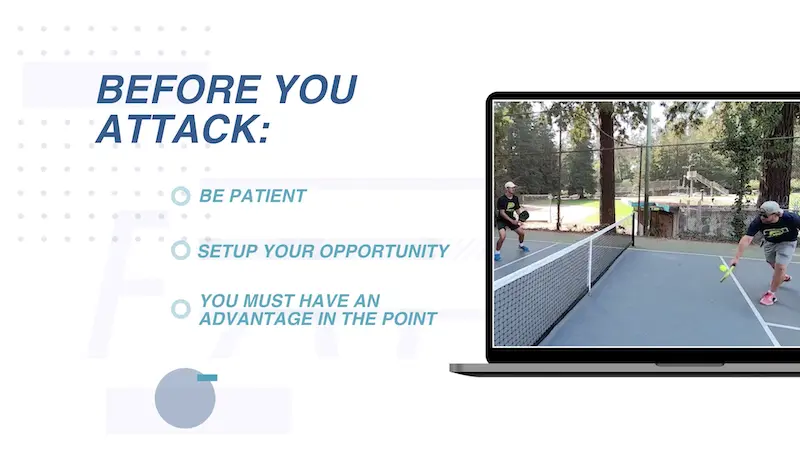
For example, you have a high contact and can hit down at them or you have them out of position and can hit to an opening. Or, you think you have just enough height to hit it fast enough so that they will get jammed up and either missed a shot or pop up an easier one you can then finish.
Keep your foot on the gas and continually pressure them without risking too much and don’t fly off the handle and go for broke just because you got impatient.
Be smart and keep the pressure on until you see your chance, then go for it, and be ready if it comes back. It often will.
Even though you hit a pretty good attack it may come back with a great reset or counter attack. Very good players can, and will, do this relatively frequently.
You make a good attempt and it just didn’t end the point. That’s perfectly okay. That happens all the time and it’s normal.
So, start over with your setup and then attack again with another strong attempt. Do that again and again and eventually you will convert if you set it up well and back it up well with good counter attacking and resetting.
What’s not good is when you go for an attack from a compromised position. Sometimes you’ll get lucky and win the point but statistically you’ll lose those more often than you win them therefore you’ll lose the game in the long run.
With that in mind, we’ll go into several attacking mistakes we see very often on the courts. If any of these seem familiar to you, and can be found in your game, then you’ll want to clean that up immediately.
Mistake #1 – Attacking From Too Low & Too Close to the Net

One big attacking mistake that we see, that really just makes absolutely no sense to attempt, is to execute an attack from a very low contact point. So low that you really can’t even get under it enough to hit any topspin.
And even if you could, because of the limits of what a paddle can do with the pickleball, you couldn’t even realistically put enough spin on it to get it up and over the net and in the court if you hit it hard.
And of course there’s an opponent there, so you have to hit it pretty hard because your only hope is to try and overwhelm your opponents with speed. If they aren’t overwhelmed then they have a high contact point with which to basically crush you with on the very next shot.
The closer to the net you are when you attempt this attack, the worse off you will be because you’ll have to hit it more vertical from closer to the net than from further back.
A low contact point attack from further back is still a bad idea because although it will not be as vertical and you can hit it somewhat straighter, you’re still hitting it up into your opponent’s high contact point and they’ll be able to hit down back at you.
It’s a losing proposition in the long run if you rely on this as an ongoing strategy unless you’re facing significantly weaker opponents.
Now, with that in mind, we’re not saying you shouldn’t attack any balls that are below the height of the net. You absolutely should. And in fact, you must. Because gone are the days when you can wait for a ball to be clearly above the height of the net to attack on.
Players are getting much better at keeping dinks low. Forcing them to pop one up very high with your aggressive dinking alone is a tough proposition these days.
Though it does happen, it happens less and less.
They’ll attack you long before you ever get that high pop up and they’ll do it point after point.
You absolutely must get adept at attacking from below the net and you have to find the range that works for you.
By far and away, the most used and winning strategy for a below net height attack is to attack the player’s hitting side, waist to chest, or even shoulder area if you feel they can’t get out of the way fast enough before it goes out.
Or, you feel you will hit it with enough topspin to keep it in. Right near the armpit is a really good spot. It’s very hard to defend that with a forehand or a backhand. If you can flick it there fast enough to jam them then you’re in good shape.
Be ready for the counter attack and attack again if you can or reset if it was a very good counter attack.
The key is the attack can’t be mediocre and weak. It must press them and jam them at least somewhat in order for you to have a chance at this being a winning strategy.
You will have to assess the skills of your opponent to determine what will jam them and what won’t and adjust accordingly.
Mistake #2 – Attacking From Out Of Position (Horizontally)
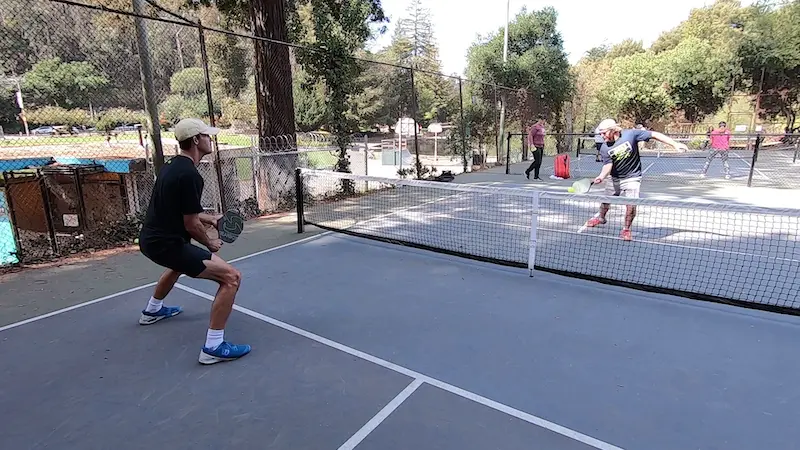
Another thing we see is attacks from way out of position horizontally. Meaning, you’re pushed out wide to one side or the other and are attacking from out there with a body attack to your opponent.
If you hit an ATP of course that’s fine because you’re hitting to an opening on the court and your opponent will be on major defense if they are able to get it back at all.
But a body attack gives your opponent a chance to get a paddle on the ball and simply block it back to the big opening you’ve created.
Every now and again you may hit it perfectly and totally handcuff and jam your opponent but more often than not you’ll probably end up on the losing end of that situation. Strategically it’s just not smart.
If you’re attacking to the body, you should attack from a position that still leaves your team covering the court well from the next shot which is a high chance of being a counter attack.
You don’t want to leave big gaping holes on your side. Particularly when your opponent is likely going to a counter-attack or hit blocks from up at the non-volley zone line. All they have to do is redirect it into the open space and your toast.
Mistake #3 – Attacking From Out Of Position (Vertically), Low Contact, Too Far Back & Possibly Off Balance
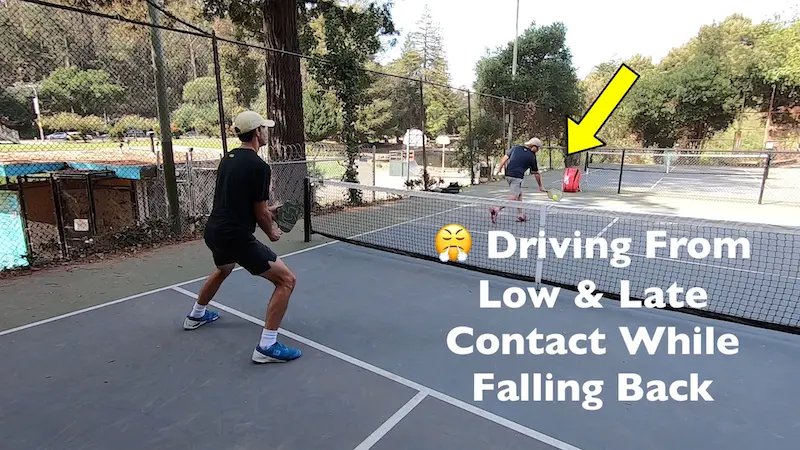
We already touched on this next one somewhat and will expand a bit here.
Attacking from too far back is often problematic. It’s okay if you’re further back and if the ball is on the higher side and you want to drive, potentially overwhelm them with pace, and draw an error.
But more likely look to get another shot that you can drop and come in.
However, if you’re already up at the line and are stepping way back, possibly even falling back, and attacking from a low contact as well, then my apologies for being so blunt, but that’s just pretty dumb.
You could get very lucky from time to time and draw a miss but in general this is a losing strategy because you are currently losing the ground war.
They are up and you are further back, hitting it hard into their high contact point and they can hit down and away or down at your feet forcing you into a very defensive position that you may get out of but it’s going to be tough.
Putting yourself in a position where you have to dig yourself out of a hole time and time again when you’re playing an evenly matched opponent is not going to go well for you most of the time.
Now, if you’re doing a small step back and the ball bounces high then that’s a different story. That’s not what we’re talking about here. That can make sense. in the right circumstances.
A step back attack with a low contact point is just not that smart and not going to work out well at higher levels.
Mistake #4- Not Resetting Your Paddle Fast Enough/Not Being Ready for Counterattack
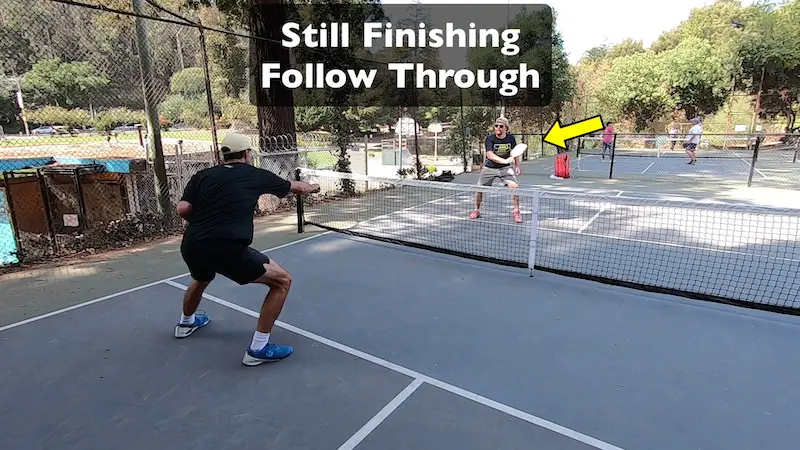
Next up is not resetting your paddle fast enough or not being ready for the counter-attack.
These are similar and result in the same outcome when you’re at the net dealing with attacks and counter-attacks.
The one thing you are majorly short on is time. There’s little time to see, think and move. And, there definitely isn’t very much time to swing.
I mean you have to swing right? You have to hit the ball and send it over. But you have to keep it compact.
You need a very short take back and follow through. Your follow through needs to transition into a ready position very quickly.
Some people often use too long of a follow through and the next shot is back on top of them and pass them before they know what happened. They weren’t really ready for the counter-attack.
You must be ready for the counter-attack and expect it.
With that in mind, think fast and keep your movements small, especially the follow through. Get ready to counter attack or reset when you attack. Chances are it’s coming back against strong opponents.
Mistake #5 – Weak Backhand Attack
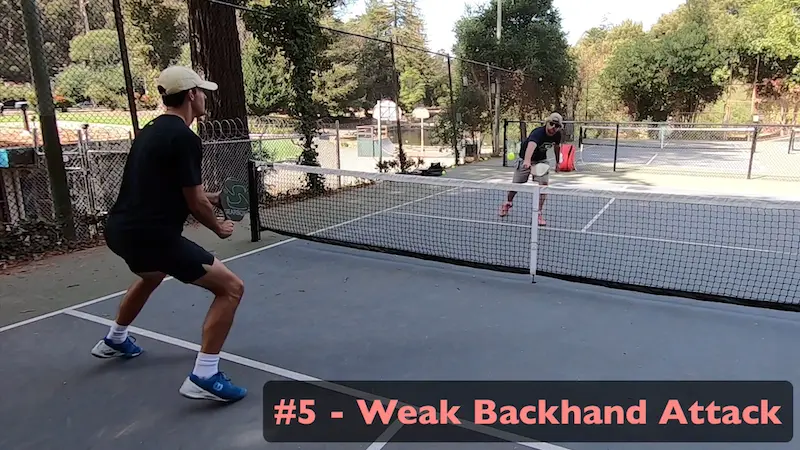
Finally we’re going to talk about backhand attacks.
You’re up at the line and here comes a juicy ball that’s just sitting there and it’s nice and high, just begging to be crushed. But, it comes to your backhand and you think “I wish this were on my forehand”.
If that’s you, then pay attention. That’s a major weakness in your game.
You don’t like your backhand.
How much more fun would you have on the court if you liked your backhand?
Work on your backhand attacks and work on your backhand in general. Having a reliable backhand will pay huge dividends across your whole game.
Get on the wall and hit backhands by yourself. It will pay off.
If you’re playing a weaker opponent or team then you can and probably will get away with making any or all of the mistakes outlined here but you’re not doing yourself any favours because you will pay the price on higher level courts.
They will handle you easily because they know how to make you pay for these mistakes time and time again.
Clean up these mistakes and hit the strategically smart shot no matter who you’re playing against. It will pay off down the road and your game will thank you.